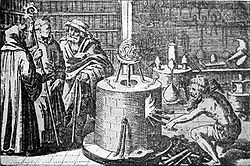Like alchemy in visual art, the intersection of alchemy and literature can be broken down into four categories:
In the second category are critiques of alchemical charlatanism. Starting in the fourteenth century, some writers lampooned alchemists and used them as the butt of satirical attacks. Some early and well-known examples are:
In twentieth and twenty-first century examples, alchemists are generally presented in a more romantic or mystic light, and often little distinction is made between alchemy, magic, and witchcraft. Alchemy has become a common theme in fantasy fiction.
Literary alchemy
The term "literary alchemy" dates back to at least 1971, when Jennifer R. Walters used it as the title of her essay Literary Alchemy in Diacritics magazine. Stanton J. Linden, in his 1996 Darke Hierogliphicks; Alchemy in English Literature from Chaucer to the Restoration, applies the term both to stories which deal extensively with alchemists and the process of alchemy (of which the earliest is Chaucer's The Canon's Yeoman's Tale ), and stories which include alchemical allegory or imagery (of which the most extensive and well-known is the Chymical Wedding of Christian Rosenkreutz ). John Granger, who studies the literary alchemy in J. K. Rowling's, Harry Potter series explains:
If you recall your Aristotle on what happens in a proper tragedy, the audience identifies with the hero in his agony and shares in his passion. This identification and shared passion is effectively the same as the experience of the event; the audience experiences katharsis or "purification" in correspondence with the actors. Shakespeare and Jonson, among others, used alchemical imagery and themes because they understood that the work of the theater in human transformation was parallel if not identical to the work of alchemy in that same transformation. The alchemical work was claimed to be greater than an imaginative experience in the theater, but the idea of purification by identification or correspondence with an object and its transformations was the same in both. [10]
In an early example, Sir Thomas Malory uses alchemy as a motif that underlies the personal, psychological, and aesthetic development of Sir Gareth of Orkney in Le Morte d'Arthur. [11] Sir Gareth's quest parallels the process of alchemy in that he first undergoes the nigredo phase by defeating the black knight and wearing his armor. After this, Gareth defeats knights representing the four elements, thereby subsuming their power. In fighting and defeating the Red Knight (the overall purpose of his quest), he undergoes and passes the rubedo phase. Gareth, toward the end of his quest, accepts a ring from his paramour, Lyoness, which transforms his armor into multicolors. This alludes to the panchromatic philosopher's stone, and while he is in multicolored armor, he is unbeatable.
The Tempest is the most alchemically influenced of all William Shakespeare's work, steeped as it is in alchemical imagery (dying Kings and sons, Ariel as the spirit Mercurius etc.) with Prospero as the archetypal Magus. The main character in the play Goodnight Desdemona (Good Morning Juliet) , by Ann-Marie MacDonald, succeeds in determining the alchemy behind Shakespeare's Othello . [12] Literary alchemy continues to be popular in novels such as Paulo Coelho's The Alchemist (1988).
David Meakin, in his 1995 book Hermetic Fictions; Alchemy and Irony in the Novel is unusual in categorizing stories as alchemic even if they do not mention alchemists or alchemy, nor include alchemic allegory or imagery, so long as they include elements which obliquely remind him personally of alchemy. For instance, he considers any book about a writer alchemic, because "writing is a kind of alchemy." Captain Nemo's submarine the Nautilus is "alchemic" because it is a "hermetically closed cell" (all submarines are airtight, ergo "hermetically closed"). The game from Hermann Hesse's The Glass Bead Game is concerned with the quest for perfection of knowledge, therefore Meakin considers it "an intellectual alchemy." The list of authors who do not mention alchemy or alchemists, nor use alchemical allegory or imagery, but who use ideas which obliquely remind Meakin of alchemy include Charles Williams, [13] William Godwin, Percy Bysshe Shelley, Émile Zola, Jules Verne, Marcel Proust, Thomas Mann, Hermann Hesse, James Joyce, Gustav Meyrink, Lindsay Clarke, Marguerite Yourcenar, Umberto Eco, Michel Butor, Amanda Quick, Gabriel García Marquez and Mária Szepes. [14] [Mikhail Bulgakov] "The Master and Margarita"


